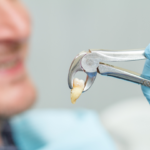
What Can I Eat After Tooth Extraction
November 22, 2023
What is a Smile Makeover?
December 27, 2023Key Takeaways:
Distinct Areas of Expertise:
Dentists provide comprehensive oral healthcare, focusing on prevention, diagnosis, and treatment of dental issues. Orthodontists specialize in aligning teeth and jaws, often treating misaligned bites and overcrowded teeth.
Education and Training:
Both professionals complete dental school, but orthodontists undergo an additional two to three years of specialized training in orthodontics.
When to See Each Professional:
Routine dental checkups and treatments are handled by dentists. For alignment problems or bite corrections, a referral to an orthodontist is necessary.
When it comes to improving the appearance and functioning of teeth, both orthodontists and dentists can help. However, these doctors differ in learning, treatment, patient, and cost. Finding the right dental professional to treat your teeth will ensure you get the best care.
Compare the roles of an orthodontist to those of a dentist to know when you need to see each one.
What Do Dentists and Orthodontists Study?
Orthodontists and dentists have the same starting education. Both types of doctors complete bachelor’s degrees before they earn their dental degrees from a school of dentistry. Therefore, both have the same qualifications to practice dentistry in most places.
Orthodontists differ in their extra learning. They must have 3,700 additional hours of training to earn their specialty in orthodontics. This field is an area of dentistry that focuses on how the soft tissues, facial bones, teeth, and jawbone move. Their education makes orthodontists capable of understanding how to realign the teeth with orthodontic treatments.
What Treatment Options Do Orthodontists and Dentists Provide
As with their education, dentists and orthodontists also have some overlap in the treatments they offer.
Treatments from Dentists
Dentists are your first contact for most of your oral health needs. If you have concerns about your teeth or gums, a dentist can help. They offer cleanings and checkups to ensure that your teeth stay healthy. Dentists can also provide cavity fillings, extractions, crowns, dentures, and other ways to restore your smile. Finally, they offer cosmetic treatments to whiten, straighten, and improve teeth.
Care Offered By Orthodontists
Orthodontists typically focus only on the alignment and movement of the facial bones and tissues. Your dentist may refer you to an orthodontist if you have a severely misaligned bite. The treatments offered by orthodontics include braces, surgery, retainers, and mouthguards to protect or realign the bite. Sometimes, orthodontists may offer clear aligner trays as an alternative to braces. Research the type of aligners they have authorization to provide to their patients. Not all orthodontists will have the specialty training needed to offer Invisalign aligners.
When Do You Need an Orthodontist vs Dentist
Orthodontists and some dentists can help when you have bite problems. However, you need to know which professional to make an appointment with. The following can help guide you in seeking the right treatment expert.
When to See an Orthodontist
Orthodontists treat alignment and bite problems in the mouth. Therefore, you might need orthodontic treatment if you have issues with crowded teeth, misaligned or misspaced teeth, biting the cheek, or protruding teeth. For instance, if you or your child has a problem with the lower teeth biting the roof of the mouth, this severe bite issue may need an orthodontist’s diagnosis and treatment.
When to Make an Appointment with a Dentist
Dentists can respond to any type of care you may need for your teeth or gums, so if you have a question about dental alignment, gum pain, or tooth problems, see your dentist first.
A visit to your dentist can ensure that you have healthy teeth and gums before starting orthodontic treatment. Plus, your dentist may have a solution to help correct your bite issues, saving you a trip to a specialist.
Cost for Treatment
The cost of going to a dentist compared to seeing an orthodontist relies directly on the type of treatment you need and your insurance benefits.
Because orthodontists are specialists, you may spend more on a visit than one to your dentist. Additionally, some dental plans may not cover orthodontic treatments. Before visiting any dental specialist, check your dental insurance benefits to find out what the plan covers and how much.
Options for Adults Who Need Dental Alignment Care
Adults with bite problems have different treatment options available to them, including braces and Invisalign aligners. Generally, orthodontists provide the former, and a few select dentists with extra training offer the latter.
Braces
Braces have many forms, including the following:
- Traditional metal braces have metal brackets and wires that fit across the front of the teeth.
- Ceramic braces replace metal brackets with less visible ceramic brackets. You will still have metal wires connecting the brackets, and the ceramic brackets are more delicate than metal ones.
- Lingual braces have brackets, and wires affixed to the back of your teeth to hide them from view.
These all include wires and brackets that attach to the teeth to pull them into place over several months up to three years. You wear braces all the time and will need to adopt special brushing, flossing, and eating habits to care for your orthodontic work and teeth.
You need to see an orthodontist to get braces. During treatment, you will need to return to your orthodontist several times to have the braces tightened. How many times you need your braces tightened depends on how far your teeth need to move to restore alignment.
While most people who get braces are between nine and 14, adults can also wear them. A dentist can let you know if you need to consult with an orthodontist about braces.
Invisalign
You may not need to go to an orthodontist if you want to improve the alignment of your smile. Invisalign aligners can help most adults and teens who want straighter teeth.
This system uses multiple custom-created trays that you wear over your teeth. The clear material ensures that the trays remain virtually invisible, so they won’t mar your smile as wire braces do.
Plus, you can remove the aligners as needed when you need to eat, so you don’t need to change your diet while you straighten your teeth.
To obtain the Invisalign system, you must consult with a qualified Invisalign dentist who has the necessary training and equipment to prescribe these aligners properly.
Not everyone benefits from Invisalign aligners, but those who do can see changes in their smile in a few weeks. Consult with an Invisalign-qualified dentist to find out if this solution can help you.
Worried About Your Smile? Make an Appointment to See If Langley Dental Care Can Help
Do you want to find out if you qualify for Invisalign aligners as an alternative to traditional orthodontic braces? Call us today at Langley Dental Care to schedule a visit to learn if Invisalign is a good option for you.



